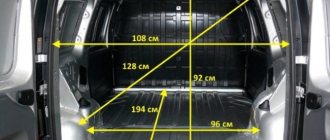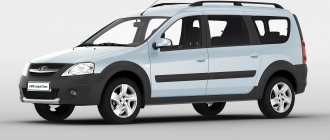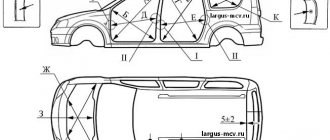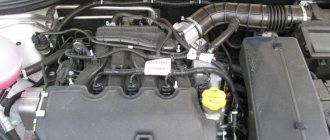The tall Lada Largus station wagon was one of AvtoVAZ’s bestsellers even before the update, however, whatever one may say, it stood out from the lineup, in this sense joining the Niva family, which does not have an X-face.
And now, finally, we see on the façade of the Russified French model (Largus, we recall, traces its ancestry to the Dacia/Renault Logan MCV of the first generation) X-strokes, a hood that has improved overall aerodynamics, as well as more efficient headlights borrowed from the new generation Renault Logan .
The sides are decorated with mirrors with built-in turn indicators from the Lada Vesta family. At the same time, we have a commercial modification on test - an all-metal van, for which, as you know, the top-end Luxe version is not available, but the test subject nevertheless sports bumpers painted in body color and alloy wheels.
Features of the Largus Van model
Although this utility vehicle is produced at the AvtoVAZ enterprise and is endowed with Lada emblems, it was developed jointly with the Renault concern, in a sense it can also be considered a French (Romanian) brand. Since 2012, the model has been produced without restyling and any global modernization, unless you take into account the changed range of engines and the appearance of a modification with gas equipment (LPG).
The Largus Van is equipped with only one row of seats and has an impressive cargo compartment with three doors (two side doors and a rear double door), which ensures convenient loading and unloading of transported goods or things. There is a removable partition between the passenger cabin and the cargo compartment; there are no side trims inside the van (only painted metal).
The rear swing doors of the body can be fixed in three positions - at opening angles of 40, 90 and 180 degrees , the side doors here open wide. In all configurations, except the simplest one, a polyethylene floor mat is provided in the cargo compartment; the van also has a backlight and six mounting loops for securing luggage. The cargo compartment is characterized by a flat floor, no thresholds, and a fairly low and therefore comfortable loading height.
In a working way
Photo: Boris Zakharov
The cabin is even more “Frenchized”. The front panel with a deep and therefore convenient storage niche on its right side and the center console with a trio of air conditioning toggle switches are painfully familiar from the Renault Duster of the previous generation, and, I must say, the new environment suits the VAZ hard worker very much.
Equally important, it has improved ergonomics. For example, to the right of the 7-inch multimedia touchscreen there is a power USB slot for quick recharging and integration of gadgets, power windows are finally located on the door armrests, and the seats, borrowed from the Renault Sandero family, received a more “human” settings algorithm.
For example, now you don’t need to jump in the driver’s seat like a ball to adjust the seat height. The only pity is that the fashionable steering wheel, taken from the Lada Vesta, is adjustable only by tilt, and using the mechanical handbrake is not very convenient due to the armrest box hanging over it.
Separately, it should be said about the standard plastic partition separating the cabin from the cargo bins. This element, of course, is needed for safety. During sharp braking, a composite but durable wall will prevent luggage from flying onto the back of the riders’ heads.
However, because of this fence, it will not be possible to recline the seat backs far back; besides, alas, VAZ did not provide any deep storage shelves (there is space for them both above the windshield and above the headrests of the seats), or even hooks for clothes. As a result, everything unnecessary has to be kept in the cargo compartment. However, the design of the partition can be modified by unscrewing several Torx screws. Then you can remove the “fence” completely, or one of its two parts. By removing the right sector, it will be possible to strongly tilt the back of the passenger seat and transport “oversize” items up to 3 meters long.
As for loading potential, Largus is at its best here, since things can be thrown into the body both from the sides (through wide doors) and from the rear - through asymmetrical hinged doors that open 180 degrees. The floor, lined with impact-resistant plastic, has mounting lugs, a powerful light on the ceiling, and a 12 V socket in one of the walls.
Only the budget algorithms for increasing the rigidity of the body structure were discouraging. Triangular guides supporting the body walls are welded directly onto the wheel arches protruding into the cargo “box”. Such a heap steals useful space. How nice it would be if the arches were placed in plywood boxes, like those of other competitors. Then on these tables, like on shelves, it would be possible to place cargo - VAZ people take note!
Largus Van interior
The interior of the cargo-passenger Largus is designed to seat two people (driver and one passenger) and is equipped with seats with mechanical adjustment in four directions. What else can be noted in the car interior:
- the steering column is adjustable, but only in height;
- the chairs are generally comfortable, but with insufficiently rigid backrests;
- the ceiling in the cabin is high, there is more than enough headroom;
- the instrument cluster has speedometer and tachometer dials on the sides, a small monochrome display occupies the middle position;
- almost all control elements (keys for power windows, central locking, emergency lights, handles for air conditioning and heating systems) are located centrally on the dashboard or on the center console, there is also a 12-volt socket;
- steering wheel - three-spoke, without keys;
- there is no interior mirror;
- The interior door panels are made of hard plastic.
The seat heating buttons are installed on the sides of the seats themselves, on the door side, but in the poorest configuration they will not be there, as well as the ESP buttons. The air ducts on the dashboard are round in shape; in appearance they resemble deflectors from a Gazelle.
Largus van cargo compartment dimensions and load capacity
The trunk volume of the Largus Station wagon directly depends on the number of installed rows of seats. In liters this will be respectively: 135/560/2350
Load capacity may vary slightly depending on modification. Average - about 550 kg. (more precisely in the characteristics)
Dimensions of the cabin and luggage compartment (for transportation of long cargo)
The length of the cabin from the trunk door to the windshield in the area of the dashboard is 3 m. 14 cm. Distance from the trunk door to the dashboard
2 m. 70 cm. The diagonal size of the cabin (from corner to corner) is 3 m. 24 cm. The width of the cabin behind the front seats is 1 m. 43 cm. The width of the cabin at the shoulder level of the third row passengers is about 1 m. 29 cm. . Distance from the threshold of the trunk door to the folded rear seat of the second row (it stands upright)
1.5 m. (max 1.66 m.) With the rear seat completely removed, the distance will increase by another 20 cm.
To transport long items, fold down the backrest of the second row and recline the backrest of the front passenger seat onto it. An extra-long weight can be rested with one end on the instrument panel, just be sure to place something soft so as not to scratch the plastic. And secure the length with a seat belt.
L1 - 910-1120mm, L2 - 590-790mm, H - 1310mm, H1 - 1080mm, H2 - 1020mm, B1 - 1380mm, B2 - 1405mm, L3 min/max - 1250/1700mm, B3 min - 1000mm, H3 - 475/ 1050mm, H4 - 920mm, Vbag. - 488 l.
Approximate internal dimensions of the luggage compartment Largus Station wagon
Internal dimensions of Largus Van
The internal volume of the serial Largus van is 2.54 m³.
Dimensions of the trunk door opening: height 92 cm, width 96 cm. Diagonal from top corner to wheel arch: 128 cm. Internal distance between wheel arches 96 cm.
Distance from the edge of the trunk to the partition: 194 cm.
Dimensions of doorways, trunk, hood, etc.
Even when I was choosing a car, I tried to find the dimensions, but nothing was written) Many people still ask me questions.
So let's blog.
The length at the bottom is 187cm. Smaller on top, because... The cabin is separated from the body by a “7” shaped partition.
The height of the opening at the back is 92cm. Again, then there is more space, after the opening there is about a meter there.
The opening width is 108cm.
The width of the floor between the wheel arches is 98 cm.
The width of the floor after the arches (the actual width of the compartment) is 134 cm.
The width of the side door opening is around 61cm.
Takes a ton with a bang)
Sofa? No problem!
Largus everyone, pasans))
z.y. We are expecting slippers from Japan) tires 215/40/18 are already lying around and waiting in the wings!
Engines and transmission
From the very beginning of production, the Largus F90 was equipped with two 1.6 liter gasoline engines from the French company Renault with the indices K7M (8-cl., 84 hp) and K4M (16-cl., 105 hp), but in Later, these engines were replaced by domestically produced engines. The K7M was replaced in 2015 by the eight-valve internal combustion engine VAZ-11189, and in 2017, instead of the K4M, the car received a sixteen-valve VAZ-21129.
All Largus Van variants have a manual transmission (5 steps), provided by French developers; manual transmission models are JR5 and JH3. The VAZ-11189 brand is an in-line four-cylinder engine with a volume of 1596 cc. cm , 8-valve, has the following data:
- max power - 87 hp. With. ;
- fuel system type - injector;
- torque max - 140 N*m ;
- timing drive - belt type;
- compression ratio - 10,5;
- compliance with environmental standards - Euro-5;
- Recommended fuel is AI-92 gasoline.
The engine of model 11189 allows Largus to accelerate to 158 km/h and reach a hundred in 15.4 seconds . Average fuel consumption per 100 km with an 8-valve VAZ engine, according to the automaker, is 8.2 liters , gasoline consumption in the city and on the highway is 10.6 and 6.7 liters , respectively.
The 21129 gasoline engine was launched into production in 2015 , originally intended for the Vesta and Xray car series. The engine has been installed on Largus since October 2017 ; it also meets the requirements of Euro-5 environmental standards. Characteristics of this internal combustion engine:
- volume - 1596 cubic meters. cm ;
- max power - 106 hp. With. ;
- torque max - 148 N*m ;
- valves per cylinder - 4;
- gas distribution mechanism drive - belt;
- compression ratio - 10,5;
- type of fuel system - injector.
Engine 21129 also easily “digests” 92-octane gasoline and provides the F90 van with acceleration to “hundreds” in 14 seconds , with a maximum speed of 165 km per hour . The fuel consumption of a utility vehicle per 100 km with a sixteen-valve VAZ engine in highway/city/average modes is 6.4/10.4/7.7 liters , respectively.
Volume and dimensions of the luggage compartment of the Largus family
So, we present the contenders for the championship title in the category “The most spacious trunk for 500 thousand rubles”:
New Lada: New Lada Largus Wagon 5 seats: configurations and prices - buy Lada Largus Wagon 5 seats in Moscow on credit and Trade In
The 5-seater Lada Largus with a load capacity of up to 445 kg, according to official information from AvtoVAZ, has a luggage compartment with a volume of 560 liters. With the rear row seats folded down, 2,350 liters of usable space are available to accommodate cargo.
The linear dimensions of the compartment have the following values:
- Trunk length 90 cm or 174 cm (to the level of the backs of the front seats);
- Actual compartment width 134 cm;
- The height of the rear door opening is 92 cm.
In the 7-seater modification of the Lada Largus, the load capacity declared by the manufacturer is increased by 35 kg compared to its 5-seater brother due to the reinforced suspension. The trunk is designed for 135 liters of cargo. By folding the backrests of the third row of seats, you can increase the luggage volume to 560 liters. A maximum capacity of 2,350 liters is provided when all rows of seats except the first are folded down. The Lada Largus Cross also shows similar load capacity parameters.
The following video describes the procedure for dismantling the right-side seats for transporting cargo over two meters long:
Warning! Stowing cargo above the openings of the side and rear windows seriously impairs visibility. Be careful when driving so as not to get into an emergency situation.
Another unique modification of Largus is a van, suitable for transporting small quantities of various goods or for use as a traveling vehicle for repairmen, builders and other technical services.
The Largus cargo van has a load capacity of up to 750 kg. The length of the luggage compartment is 194 cm at floor level; at roof level the size is reduced due to the shape of the cabin partition. The floor distance between the rear wheel arches is 96 cm, the actual width of the cargo compartment is 134 cm. The width of the side door opening is about 61 cm.
Reminder! Unless absolutely necessary, you should not exceed the maximum load capacity established by the manufacturer, even if the luggage compartment space allows it. In this case, there is a high probability of damage to the vehicle’s suspension elements.
Among the products of the Russian automobile industry in the station wagon body are the Lada Priora and Lada Kalina 2 cars.
For the Lada Kalina 2 (VAZ 2194), the name “station wagon” rather informs about the body type than indicates serious load-carrying capacity. The luggage compartment capacity is 355 liters (with the rear row of seats folded - 670 liters), which is comparable to that of full-size sedans. Based on the dimensions of the Kalina platform, the linear dimensions of the luggage compartment are also very modest.
Lada Priora (VAZ 2171) is a five-seat front-wheel drive station wagon capable of carrying up to 400 kg of payload in a 444-liter trunk (excluding the weight of the driver and passengers).
With the rear seats folded down, the cabin can accommodate 777 liters of cargo (up to the level of the window openings).
The depth of the trunk is 98.5 cm (164 cm with the seats folded), the height from the trunk floor to the roof of the cabin is 84.5 cm, and the maximum width of the luggage compartment is 150 cm. The loading opening is limited by the tailgate, which opens upward.
The Ukrainian clone of Lada 2111, the Bogdan station wagon, has similar load-carrying capacity indicators. In addition, the design of this model has become morally and physically outdated more than 20 years from the start of serial production.
All these options can, with some stretch, be considered as cars with characteristics close to the 5-seater Largus. And if it is necessary to accommodate 7 people with luggage in the car, in addition to the Lada Largus, domestic manufacturers can only offer shortened versions of Gorky’s GAZelles.
To compare with the Largus van, among Russian cars we can mention pickups from the Samara “VAZINTERSERVIS”, such as the LADA Granta VIS-234900 with a 3900-liter van and a load capacity of up to 720 kg. However, this is still a remake (albeit a factory one), and prices for VIS start at 600 thousand rubles.
Specifications
The Lada Largus Van model is a light commercial vehicle with a van body, designed to transport cargo weighing up to 725 kg . The vehicle is also capable of additionally towing a trailer weighing up to 650 kilograms , and if the trailer is equipped with brakes, its weight can be increased to 1300 kg . Other technical characteristics of the machine:
- two seats in the cabin ;
- number of doors - five (rear door - double-leaf);
- van volume (cargo compartment) - 2540 l ( 2225 l for the gas version);
- gas tank capacity - 50 l ;
- length/height/width of the car - 4.47/1.65/1.75 m ;
- wheelbase - 2905 mm ;
- front wheel track - 1469 mm (for the rear axle - 1466 mm );
- ground clearance - 145 mm ;
- curb weight - 1260 kg (for the version with LPG - 1380 kg );
- total weight - 1985 kg ;
- The minimum turning diameter is 11.25 m .
Largus Van is equipped with MacPherson front suspension, a beam is installed at the rear, and factory tire sizes are 185/65R15 . The brakes on the car are discs in the front and drums in the rear, the wheel drive is front-wheel drive in all versions. In any configuration, Largus Van is equipped with stamped 15X6J wheel disks, and a mechanical parking brake is installed on the vehicle.
Read also: Suzuki Jimny - the “little prince” of the world’s roads
What is the carrying capacity of the Lada-Largus: comparison with competitors
The certified carrying capacity of all modifications of the Lada Largus, calculated as the difference between the curb and gross weights of the vehicle, has the following values:
- 445 kg for a 5-seater station wagon;
- 480 kg for the 7-seater version and for Largus Cross;
- 750 kg for a van.
Undoubtedly, the characteristics are impressive for a B-class family car, and the Largus van is comparable to the capabilities of representatives of the commercial LCV segment, such as the GAZ-2752 Sobol.
However, considering cargo capabilities only in terms of payload is not entirely correct. After all, humanity invented trucks to transport cinder blocks and floor slabs. And for a typical station wagon owner, the most important thing is to answer the question of whether he can carry ten packs of insulation at a time, and whether a two-meter refrigerator will fit into the cabin.
Therefore, it is possible to more objectively assess the cargo capabilities of the Lada Largus based on the volume of the luggage compartment and its dimensions (depth, width and height).
In addition, we should not forget about the price component: the Audi allroad station wagon with a three-liter engine has a comparable maximum load capacity of 500 kg, but the cost is equal to 8.5 Largus.
Standard configurations and prices
The Largus Van does not have a lot of optional equipment, although it is offered in several trim levels:
- “Standard” (factory index - FS035-50-ACA);
- "Standard Start" (FS035-50-AC8);
- "Norma" (FS035-51-ACB);
- "Norma Audio" (FS035-51-ACG);
- “Norma Comfort” (FS035-51-AC7 and FS045-51-ACA);
- "Norma Comfort CNG".
Engine VAZ-21129 106 l. With. Available only in Norma Comfort and Norma Comfort CNG (with LPG) equipment, although the “Norma Comfort” modification is also available with an 87-horsepower engine (FS035-51-AC7). The basic Standard version includes options:
- driver airbag;
- EBD and ABS systems;
- immobilizer;
- light tinting of windows;
- audio training.
R15 spare tire with a steel disk, the ERA-Glonass system, and fabric seat upholstery. The price of a base car in July 2019 is 560.9 thousand rubles. , Standard Start version (already with power steering) - 575.9 thousand rubles .
Technical parameters of Lada Largus
Lada Largus does not have diesel versions in its engine line and is content with only gasoline units. In terms of technical capabilities, the manufacturer sought to make its car, first of all, accessible to a wide range of social groups.
Motors are available to choose from, both 8-valve and 16-valve versions of cylinder heads. The volume of the units is identical - 1.6 liters. Power reaches 87 “forces” and 105 “horses” depending on the number of valves.
The layout of the Lada Largus car is front-wheel drive. There is also an independent suspension design at the front, and at the rear the chassis has a semi-independent mechanism, where the torsion beam acts as the main element.
All wheels are equipped with disc brakes.
The trunk can accommodate cargo equivalent to a volume of 2540 liters.
The fuel tank can hold a maximum of 50 liters. Touching upon fuel consumption per traditional hundred kilometers, we note that this important indicator varies between 6-11 liters. This range width is influenced by the driving style and conditions of use of the car.
“Norma” configurations
The simplest of the Norma modifications is equipped with all the equipment available in the Standard; it also additionally has:
- electric windows for front doors;
- air conditioner;
- heated front seats;
- carpet in the cargo compartment;
- exterior door moldings;
- central locking with remote control.
buy the Largus Van “Norma” in July 2019 at a recommended price of 618,400 rubles . The Norma Audio package additionally includes an audio system with FM radio, MP3 support, a USB connector, Hands free and Bluetooth functions, the cost of such a car is 628,400 rubles .
The most “charged” option is Norma Comfort, here fog lights and a passenger airbag are added to all the existing options. The cost of a car in this configuration with an 87-horsepower engine is 635.9 thousand rubles. , with a 106 hp engine. With. — 655.8 thousand rubles. , with a 106-horsepower engine and HBO - 843.3 thousand rubles .
Lada Largus cargo van
In 2022, the domestic car market was replenished with a new universal model Lada Largus. This product from AvtoVAZ immediately fell in love with a wide mass of fans who value unpretentiousness and practicality in a car. Two years earlier, the prototype was first presented to the general public, and the cargo van version was positioned as a commercial option.
When compared with foreign analogues, the Russian station wagon has a significant advantage – a lower price. According to the manufacturer, the quality indicators of the Lada Largus can compete on equal terms with the advantages of such popular foreign cars as Citroen Berlingo or Renault Kangoo in cargo version.
Reviews from Lada Largus Van owners: advantages and disadvantages
Lada Largus Van is a fairly economical cargo-passenger vehicle, distinguished by practicality and reliability, with a spacious cargo compartment with a comfortable loading height. Positive reviews from Lada Largus owners confirm that the car is fully worth the investment in it and is an excellent workhorse. The advantages of this model include:
- maintainability and low cost of maintenance and spare parts;
- pretty good build quality;
- “indestructible” and impenetrable suspension, which perfectly absorbs all road irregularities;
- warm interior;
- durable paint coating;
- low price of the car itself.
The main disadvantages of the cargo-passenger Largus:
- cheap interior finishing materials;
- insufficient equipment even in the most “charged” version;
- poor sound insulation;
- not the best handling.
Many drivers also complain about the lack of a sixth gear, and the gearbox stages themselves are “short”, which is why the car constantly drives at high engine speeds. But with a load capacity of 725 kg, the car can be loaded with almost 1 ton , and at the same time it almost does not sag, obediently carrying its load.
If we consider the Largus Van as a work vehicle, it is not necessary to buy a car in the maximum configuration, but for normal comfort you definitely need power steering and air conditioning. And when choosing Largus for work, you need to understand that there are cars with significantly better characteristics, only in this price category the VAZ van has practically no competitors.
What's the result?
Photo: Boris Zakharov
In a word, the cargo Largus, despite the lack of stars in the sky, seemed to me a pleasant, comfortable and honest car.
It’s a pity, of course, that due to the impossibility of ordering such a car in a top-end configuration, you won’t be able to get a full range of warm options and, above all, a heated front windshield, as well as a rear view camera, which obviously wouldn’t hurt a rather large car with plugs instead of rear side windows would. However, there are sensitive rear parking sensors, and in the external mirrors of the Lada Vesta you see more of the road than in the more compact counterparts of its predecessor. And finally, the range of prices for a car with an initial 1.6-liter 90-horsepower engine cannot but rejoice - from 773,900 to 872,900 rubles.
In general, in the face of the restyled Largus we received the same “workhorse”, but only in a more fashionable and comfortable design. I have no doubt that this hard worker will retain its status as a bestseller, especially since the cargo version has few direct competitors in our market. For the closest competitors, Peugeot Partner and Fiat Doblo Cargo vans, they ask from 1,299,000 and from 1,595,000 rubles, respectively.
dimensions and dimensions in centimeters, length, width
LADA Largus has long won the sympathy of Russian car enthusiasts
Drivers often pay attention to the large trunk volume of the Lada Largus, which is considered the main advantage of this car. Domestic cars also cope well with another task - providing inexpensive and comfortable travel on modern roads
These two aspects and the ability to accommodate a large number of passengers allowed the car, produced at the Russian AvtoVAZ, to become a popular model in the CIS countries.
The dimensions of the Largus trunk depend on the body variation, it can be:
Each car variation has its own luggage compartment volume. In a station wagon designed for 5 seats, the volume of this compartment is 700 liters. But the owner of this model can transport a large load. In the Lada Largus station wagon, the trunk volume can be increased to 1500–1800 liters by removing the second row of seats - a three-seater sofa. With the seats folded down, the station wagon's luggage compartment volume increases to 2,350 liters.
The Largus van has the largest trunk dimensions. In this variation of the car there is no back row of seats, and sometimes even two, and the body is elongated. Officially, the van's trunk capacity is 2,500 liters. The main task of the model is to transport goods, so there are no additional components or elements inside the body.
The van has a reinforced suspension, as this model is designed for transporting large cargo. Station wagons do not have this option.
Cross
The smallest trunk size is in the Largus minivan, designed for 7 seats. The Largus Cross trunk reaches a volume of 200 liters. The manufacturer helped car owners by allowing them to increase the volume of the luggage compartment in liters to 1600–1800, for which two rows of seats should be removed.
The seven-seater version (minivan) has the most “modest” luggage compartment. But the manufacturer met his loyal customer halfway and endowed this modification with a simple secret: it is also possible to increase the luggage space to the same 1600–1800 liters by performing an identical operation to dismantle the stern seats. To do this, you will need to remove two planting rows.
Of course, neither a station wagon nor a minivan are designed to transport large loads, but if necessary, they will cope with this task perfectly.
Luggage compartment dimensions
Based on the above, we can conclude that the dimensions of the luggage compartment of any version of the Lada Largus are quite impressive. The general dimensions of this compartment for the models are as follows:
- opening height is 920 mm;
- the opening width is 980 mm;
- the height of the luggage compartment to the ceiling is from 870 to 930 mm for universal models and up to 1000 mm for a van;
- trunk length is 480–1570 mm for station wagons up to the 3rd and 2nd row of seats;
- The length of the van's luggage compartment is 1800 mm to the dividing wall;
- luggage compartment width – 1000–1450 mm.
Advantages and disadvantages
To make the right decision, you need to study not only the advantages, but also the disadvantages of the model. The owners, who have extensive experience in operating Largus, found one drawback. The car manufacturer did not adjust the interior of the station wagons in such a way that their owners would have the opportunity to transport large loads. If the driver nevertheless decided to load a large object into his car, then the cargo often caused damage to the interior.
Otherwise, Lada Largus owners are satisfied with everything in their cars. Among the advantages of a Russian car are the following:
- ease of loading;
- optimal dimensions;
- the ability to increase trunk capacity by removing the seats;
- high load capacity;
- possibility of modernization.
Drivers universally note the practicality and convenience of the LADA Largus trunk. Its size is quite enough to demonstrate the functionality of a domestic car, which allowed it to become a leader among its closest competitors. The manufacturer managed to competently and rationally approach the arrangement of the body space, which allows Largus to successfully transport large objects and indicates the enviable carrying capacity of the model.
Lada Largus is recommended for those drivers who want to get a car with the best consumer properties and technical characteristics.
Ease of use
Mitsubishi Delica D5 (“Delica D5”): description, characteristics, reviews
The practicality of the car is perfectly combined with a high level of comfort. The Lada-Largus van has a modern air conditioner and audio system, heated front seats, central locking, electric windows and other useful options that are a significant contribution to the profitability of the business. This is explained by the fact that driver comfort affects the success of transportation.
In addition to the above advantages, Lada-Largus has the following options:
- Power steering.
- The glove box is large.
- Pockets in the front doors for storing small items.
- The center console is ergonomic.
- A lighting point is integrated into the luggage compartment.
The car has high cross-country ability: ground clearance without load is 18.1 cm, with full load - 14.5 cm. The gear ratios in the gearbox are selected specifically for the cargo model.











